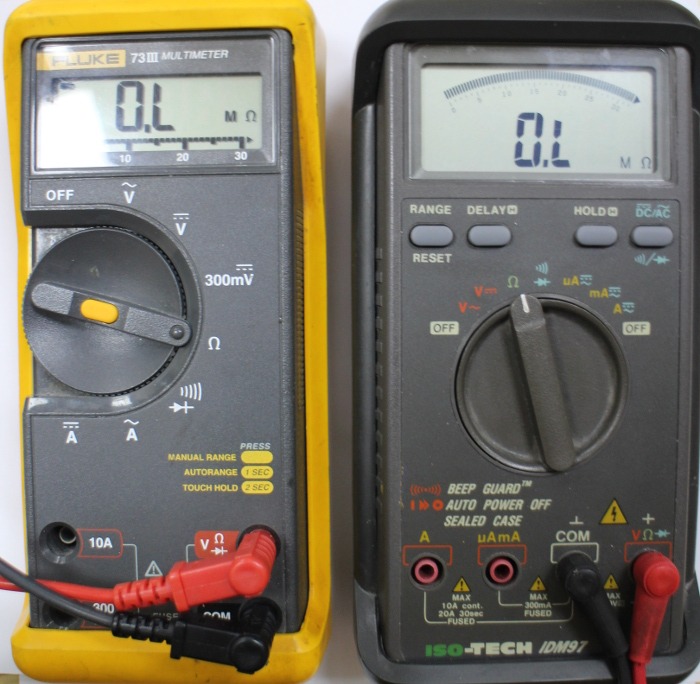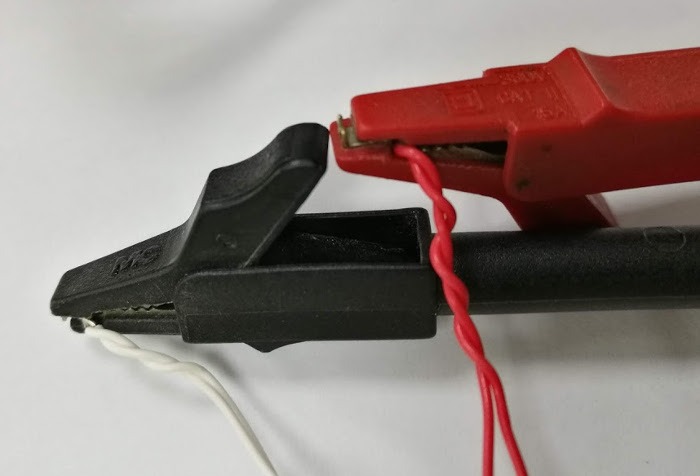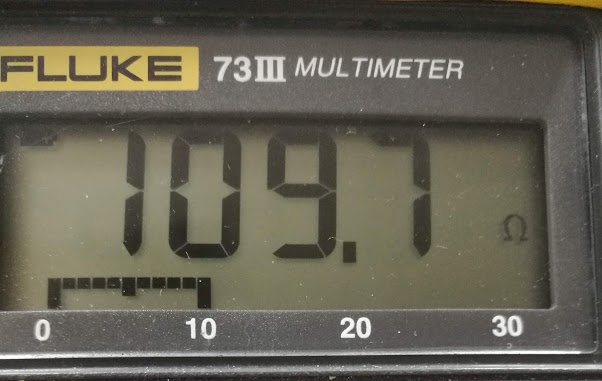How To Check Temperature Sensor With Multimeter
How to test a faulty thermocouple or resistance thermometer?
The first indication that a thermocouple or pt100 sensor is not working correctly will be from the instrument it is connected to. The readings might appear lower or college than expected or the instrument will be showing an fault code.
Instruments connected to a thermocouple or pt100 will often
be a temperature controller or a readout.
Different errors on a controller volition mean different things depending on the brand and model. Check your temperature controller manual to make sure it isn't an fault with the controller itself.
Bank check if the -ve and +ve leads swapped
If your temperature sensor is a resistance thermometer swapping the -ve and +ve leads volition not influence the reading.
Thermocouple readings do change if leads are not correctly connected.
If -ve and +ve leads are swapped between a thermocouple and an instrument then the reading will change relative to the ambient temperature e.g. a reading of 100°C with an ambience temperature of 25°C will read as 75°C, if the leads are not correctly connected. Ensure that the -ve thermocouple atomic number 82 and +ve thermocouple lead are wired correctly to your instrument.
Check for any thermocouple cable wiring issues
Incorrectly wired compensating cable
Incorrect wiring of thermocouple cables tin can be farther complicated because thermocouples oftentimes use compensating cablevision. Information technology is possible that the compensating cable is incorrectly wired to the thermocouple. Information technology may appear correctly wired at the musical instrument but not right betwixt the thermocouple and compensating cable. To avert this, make sure -ve and +ve legs match correctly along the full length of the thermocouple, to the compensating cable, to the instrument.
Using the wrong compensating type
Each compensating cable is also tied to a specific thermocouple blazon. To ensure accurateness you must only apply compensating cable of the same type e.grand. a type Grand thermocouple could just be extended with type m compensating cable. Sometimes other types of cable such as general instrument cablevision, or copper cable is used to extend thermocouples and this also creates errors.
Using compensating cablevision in loftier temperature environments
The final quirk with compensating cable is that it should not be used in loftier temperature environments. Thermocouple compensating cablevision is rated for a lower temperature than thermocouple cablevision. Try to use compensating cable in ambient temperatures to reduce errors.
Check for local rut source issues
If your thermocouple is reading high, information technology could exist because your sensor is located likewise close to a estrus source. If your sensor is near a local heat source it could increase the temperature being measured as opposed to the position you wish to measure temperature.
Check Temperature Transmitter Settings
If your sensor is using a temperature transmitter information technology is important to cheque that the output of the transmitter and the input of the instrument is the same. Most commonly a signal range of four…20 mA is used.
Cheque temperature controller settings
Check input settings on temperature controller
For case, if you have your temperature controller setup for Blazon S input but attach a Type B thermocouple sensor information technology would display an incorrect temperature and lead y'all to believe your sensor was faulty. You will need to brand sure the input selected on the controller matches the type of thermocouple or resistance thermometer connected to it.
In that location are too a couple of controller errors that point to a fault in the temperature sensor.
Instrument shows: Input signal higher or lower than limit (Out of range error)
The controller could be displaying several things indicating that it believes there is an out of range fault. Common brands of controller could show:
| Brand | Signal below limit | Signal in a higher place limit |
| Vertex | uuuu | nnnn |
| BTC Abstraction | LLEr | HLEr |
| Eurotherm | LLLL | HHHH |
| Yokogawa | uuuu | oooo |
Each brand and model of controller is different so look in your temperature controller manual to notice out how an out of range error will show on your specific model.
If you take an out of range error the input the temperature sensor is providing is out of the expected range co-ordinate to the configured input on the controller.
For instance, if you lot had your controller setup for Blazon S thermocouple input it would expect a small range of mV. If you and then continued a Type E thermocouple, a thermocouple with a much college mV range, at 300°C it would show an out of range mistake.
Instrument shows: Sensor Break Error (Open Circuit)
If the controller shows an open circuit mistake the connection to the sensor is not complete. This could mean either one of the sensor terminals is not connected to the controller or at that place is a intermission somewhere in the sensor.
Mutual brands of controller could show:
| Brand | Sensor Pause Error |
|---|---|
| Vertex | oPen |
| BTC Brainchild | SbEr |
| Eurotherm | Sbr |
| Yokogawa | —- |
Each brand and model of controller is dissimilar and so look in your temperature controller manual to discover out how a sensor interruption mistake will evidence on your specific model.
If y'all have checked that the sensor is properly connected to the controller and you still get an open circuit error you lot will need to disconnect the sensor and remove it from your process to further examination the broken thermocouple or broken thermometer for faults.
Conduct a visual cheque of the temperature sensor
After removing the sensors from your process, visually cheque for damage forth the length of the sheath and at the measuring bespeak. On a thermocouple you will have a measuring junction at the tip, on a resistance thermometer you will have an element at the tip e.thou. a pt100 element.
If there are any breaks along the sheath or the tip of the sensor is broken it will probably be the cause of the fault. If visually nothing appears to be wrong, y'all can verify any internal breaks with a multimeter.
Troubleshooting temperature sensors with a multimeter
In-caput thermocouple multimeter check
One bank check you lot can carry out with a thermocouple is if you lot short the +ve and -ve wires in a terminal connection head, if the instrument and any compensating cables are setup correctly the instrument will give an ambience reading.
Testing a faulty thermocouple with a multimeter
Go your faulty thermocouple and a multimeter.
Alter your multimeter to Continuity beeper/diode symbol/flow of current. Some multimeters will beep if there is a interruption in the circuit, some multimeters volition beep when the circuit is complete. Know how your multimeter functions.
Diode Symbol:![]()
Two multimeters showing the diode/continuity beeper setting selected:
Adhere each leg of the thermocouple to the multimeter. It doesn't matter which style the positive and negative leg are.
After connecting the thermocouple to the multimeter a working thermocouple will produce a beep (or no beep if your multimeter works the contrary way). The screen will brandish resistance in Ohms, which could be null. If there is a break it volition display OL or similar.
If yous are experiencing intermittent thermocouple failure y'all can accommodate the position of the sensor and its leads to see if y'all can trigger the error.
Testing a faulty resistance thermometer with a multimeter
In this section, nosotros volition explicate how to test RTD with a multimeter. So, after removing the faulty resistance thermometer, get your multimeter and change information technology to the Ohms setting (Ω).
Two multimeters showing the ohms (Ω) setting selected:
Adjacent connect the resistance thermometer to your multimeter. It doesn't thing which mode around the positive and negative legs are. Some resistance thermometers have 3 or 4 wires. Make certain you connect the wires of a similar colour together. Due east.g White and white connect to one terminal and reddish and red connect to the other last.
Four wire resistance thermometer connected to multimeter clips. Showing white-white and red-ruddy leads continued together:
If your resistance thermometer is continued to the multimeter and information technology is reading OL there is a possible break in the sensor. Y'all tin move whatsoever flexible cable or tails around to try and trigger any intermittent faults. In a working resistance thermometer, the multimeter would read an ohms value, an case table is below:
| Ohms reading at Room Temperature (20-25°C) | Resistance Thermometer Blazon |
|---|---|
| 107.793-109.735Ω | Pt100 |
| 538.967-548.673 Ω | Pt500 |
| 1077.935-1097.347Ω | Pt1000 |
| ~0Ω | Broken sensor or not a resistance thermometer |
Tolerance to these values would depend on the accurateness of your resistance thermometer and the actual temperature in your room.
Sample resistance thermometer reading 109.seven ohms which is effectually 25°C:
Contact Elevation Sensors
The above guide is aimed at helping you lot identify problems with your resistance thermometers and thermocouples. Peak Sensors are experts in temperature sensors and a shortcut to solving your RTD or thermocouple problems is to contact us. We tin help solve your temperature sensor bug and either repair or industry replacement sensors.
Call us: 01246 261999
E-mail the states: websales@peaksensors.com
Source: https://peaksensors.co.uk/blog/check-a-faulty-temperature-sensor/






0 Response to "How To Check Temperature Sensor With Multimeter"
Post a Comment